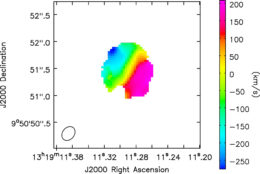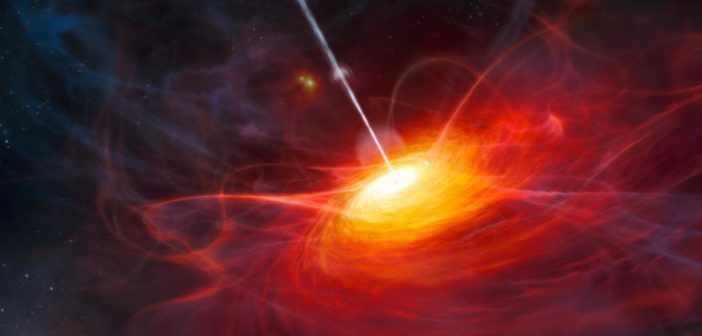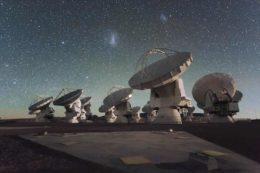How did the first supermassive black holes grow alongside their host galaxies in the early universe? New observations from the Atacama Millimeter/Submillimeter Array (ALMA) have provided us with a detailed look at one quasar, which may help us to answer this question.
Quasar-Starburst Systems
The hunt for quasars — active and bright galactic nuclei — at high redshifts is on, with roughly 200 discovered thus far at redshifts of 5.1 < z < 7. These galaxies, whose light was emitted at a time when the universe was roughly less than a billion years in age, can tell us about conditions in this early time.In particular, maybe 30% of these known quasars demonstrate active star formation in addition to significant black-hole activity. These quasar-starburst systems are unique laboratories that we can use to explore how the first supermassive black holes formed and grew along with their host galaxies in the period of time close to the end of cosmic reionization.
New observations from ALMA have now revealed a detailed look at one such quasar, ULAS J1319+0950, located at a redshift of z = 6.13. The observations, presented in a paper led by Yali Shao (Peking University and the National Radio Astronomy Observatory), have provided intriguing insight about early supermassive black hole growth.
Measuring Gas and Dust
Previous observations of the galaxy ULAS J1319+0950 gave us some tantalizing hints as to its structure and dynamics, but the limited spatial resolution of these observations prevented us from drawing firm conclusions. Shao and collaborators now combine the previous Cycle 0 ALMA observations of ULAS J1319+0950 with new, high-resolution observations from Cycle 1 to draw a detailed picture of where the dust and the atomic and ionized gas (which traces the star formation) reside in this galaxy’s core.
The authors find that the [C II] line emission is more irregular than that of the dust continuum, suggesting that the dust and the gas have different distributions in the central region of this quasar. Shao and collaborators also detect signatures that indicate that the [C II] emission line originates from a rotating gas disk. By modeling the emission, they estimate the speed of the gas’s rotation, allowing them to obtain a dynamical mass for the galaxy.
A Speedily-Grown Black Hole

Mean gas velocity map, revealing the net rotation of the gas. The authors used this rotation to measure the dynamical mass of the galaxy. [Shao et al. 2017]
Are these findings true only for ULAS J1319+0950? Or could this provide us with insight into how all supermassive black holes grew in the early universe? With the significant power of observatories like ALMA on our side, future detections should soon reveal the answer.
Citation
Yali Shao et al 2017 ApJ 845 138. doi:10.3847/1538-4357/aa826c




4 Comments
Pingback: ALMA Finds Hints of Early Black-Hole Growth – MeasurementDataBases for Industry & Science
Pingback: ALMA hints at early BH growth
Pingback: TELESCOPIO SKA – Amici della Specola Vaticana
Pingback: SKA TELESCOPE – Friends of the Vatican Observatory